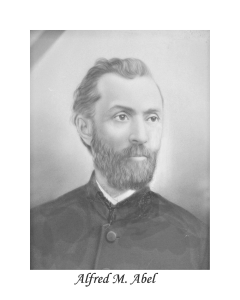 A Brief History of St. Luke’s Episcopal Church
A Brief History of St. Luke’s Episcopal Church
St. Luke’s Episcopal Church began as a missionary outreach of Hope Church, Lancaster County through the leadership of the Rev. Alfred Abel under the direction of Bishop Alonzo Potter of the Diocese of Pennsylvania. The first Episcopal Service was held in a private home in Lebanon on November 8, 1857 (St. Luke’s celebrated its 150th Anniversary from November 2007 to November 2008). Nine months later, after several more Services were held in different locations, the mission parish was officially organized on August 16, 1858 as Christ Church of Lebanon, Pennsylvania, with a vestry that included William Coleman, Samuel Herman, Antes Snyder (son of former Governor Simon Snyder), Josiah Funck, La Fayette Brower and George K. Bowen. A Record of Incorporation was filed in the Lebanon County Court on January 6, 1859. The parish was officially welcomed into the Diocese of Pennsylvania at its May 1859 Convention.
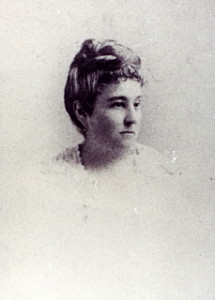 In 1861 at the beginning of the Civil War, William Coleman died at the age of 35, leaving his young widow Ellen with two small children. She continued to support the parish for 31 years. Before he died, William Coleman, provided funds to purchase land for a church building. (His grandfather Robert Coleman had donated funds in 1819 to build the current St. James Episcopal Church in Lancaster.)
In 1861 at the beginning of the Civil War, William Coleman died at the age of 35, leaving his young widow Ellen with two small children. She continued to support the parish for 31 years. Before he died, William Coleman, provided funds to purchase land for a church building. (His grandfather Robert Coleman had donated funds in 1819 to build the current St. James Episcopal Church in Lancaster.)
On May 15, 1863 the cornerstone was laid for a chapel at the corner of 6th and Chestnut Streets in Lebanon. St. Luke’s Chapel was consecrated on October 21, 1863, During the midpoint of construction, the Battle of Gettysburg took place on July 1st to 3rd, 1863, within a day’s ride from Lebanon. In 1867 a Rectory was built at 519 Chestnut Street, a 2-story brick building.
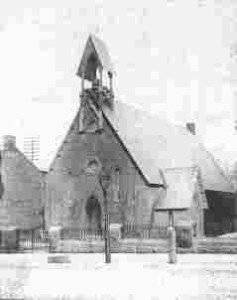 In 1871 a Free Parochial School was established by Mrs. William Coleman., and within a few years, four schools with 125 students were in operation. The Free Parochial Schools were supported by Mrs. Coleman and they continued until her death in 1892. Mrs. Coleman also sponsored several Public Reading and Recreation Rooms, one at 613 Cumberland Street. A library was established in connection with the Reading Rooms.
In 1871 a Free Parochial School was established by Mrs. William Coleman., and within a few years, four schools with 125 students were in operation. The Free Parochial Schools were supported by Mrs. Coleman and they continued until her death in 1892. Mrs. Coleman also sponsored several Public Reading and Recreation Rooms, one at 613 Cumberland Street. A library was established in connection with the Reading Rooms.
In 1878 Rev. Abel resigned as Rector and traveled on mission to Oregon Territory. There he established St. Luke’s Memorial Church, Tacoma, before returning to Lebanon County in 1881. Rev. Abel was succeeded by the Rev. Chandler Hare as Rector of St. Luke’s Church, Lebanon. In 1878 Mrs. Coleman purchased Swatara Institute (also known as Heilman Hall) and deeded the property to Bishop Howe for establishing a Church Home for Children. On November 10, 1881 the Home was opened for residents, and the Rev. Alfred Abel was appointed house father and chaplain. The Home, later named Talbot Hall, remained open for 100 years and closed in 1981.
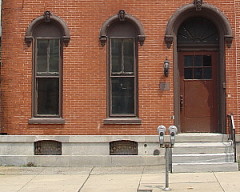 On October 18, 1879 the cornerstone was laid by Bishop Howe for a new St. Luke’s Church, built of stone in the Victorian gothic style, at the corner of 6th and Chestnut Streets. The architect for the building was Henry Martyn Congdon of New York City, a well-known designer of Episcopal churches.
On October 18, 1879 the cornerstone was laid by Bishop Howe for a new St. Luke’s Church, built of stone in the Victorian gothic style, at the corner of 6th and Chestnut Streets. The architect for the building was Henry Martyn Congdon of New York City, a well-known designer of Episcopal churches.
On October 18, 1880, St. Luke’s Day, the completed church was consecrated by Bishop Howe with many visiting Bishops attending. The original Chapel remained in place until the Parish Hall was built in 1903.
 Mrs. Coleman’s son, Robert H. Coleman, was proprietor of Colebrook Furnace in West Lebanon,. In 1885 he provided a room for Worship Services in the village (Mt. Pleasant) attached to the Colebrook Furnace. Later he provided funds for building a house of worship there, and on May 27. 1888 the cornerstone was laid for Trinity Chapel on West Cumberland Street. Trinity Chapel continued as a part of St. Luke’s Parish until 1988 when it was deconsecrated and the property was sold. Today the building known as Coleman Chapel still serves the community as a place for weddings and celebrations.
Mrs. Coleman’s son, Robert H. Coleman, was proprietor of Colebrook Furnace in West Lebanon,. In 1885 he provided a room for Worship Services in the village (Mt. Pleasant) attached to the Colebrook Furnace. Later he provided funds for building a house of worship there, and on May 27. 1888 the cornerstone was laid for Trinity Chapel on West Cumberland Street. Trinity Chapel continued as a part of St. Luke’s Parish until 1988 when it was deconsecrated and the property was sold. Today the building known as Coleman Chapel still serves the community as a place for weddings and celebrations.
The Good Samaritan Hospital was originally started as a parish hospital by St. Katherine’s Guild of St. Luke’s Church, a group of women led by Mrs. Coleman and Mrs. Chandler Hare. The house at 711 Chestnut Street was the site of their first free clinic in 1889. The charter of the Good Samaritan Hospital was filed in the Court of Common Pleas of Lebanon County on November 23, 1891
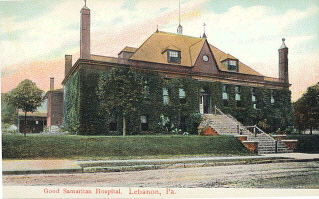 The first president of the Board of Manager was the Rev. Chandler Hare and the majority of the Board were members of St. Katherine’s Guild. Within five years of starting the first free clinic, sufficient funds were raised through the efforts of Rev. Hare, Mrs. Horace Brock and others to enable the construction of a hospital building on Walnut Street in 1894. The hospital was the culmination of Mrs. Coleman’s work in Lebanon County, for she died in 1892, two years before the hospital was dedicated. The Rev. Chandler Hare died the following year in 1893.
The first president of the Board of Manager was the Rev. Chandler Hare and the majority of the Board were members of St. Katherine’s Guild. Within five years of starting the first free clinic, sufficient funds were raised through the efforts of Rev. Hare, Mrs. Horace Brock and others to enable the construction of a hospital building on Walnut Street in 1894. The hospital was the culmination of Mrs. Coleman’s work in Lebanon County, for she died in 1892, two years before the hospital was dedicated. The Rev. Chandler Hare died the following year in 1893.
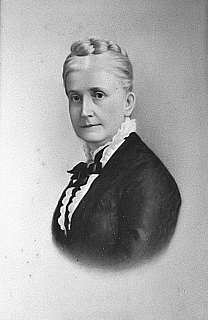 Following the Rev. James Hawkes, Rector from 1893 to 1896, the Rev. John Mitchell Page, served from 1896 to 1912. During this period the Parish Hall was built in 1903 with funds donated by sisters Isobel Freeman and Margaret Freeman Buckingham, cousins of Robert H. Coleman. In the 1930s Margaret Freeman Buckingham gave Cornwall Furnace to the Commonwealth of Pennsylvania to be a Historic Site. She also gave to the National Cathedaal in Washington, D.C. funds for the Jerusalem Pulpit and established a trust to support the work of the Canon Missioner at the Cathedral.
Following the Rev. James Hawkes, Rector from 1893 to 1896, the Rev. John Mitchell Page, served from 1896 to 1912. During this period the Parish Hall was built in 1903 with funds donated by sisters Isobel Freeman and Margaret Freeman Buckingham, cousins of Robert H. Coleman. In the 1930s Margaret Freeman Buckingham gave Cornwall Furnace to the Commonwealth of Pennsylvania to be a Historic Site. She also gave to the National Cathedaal in Washington, D.C. funds for the Jerusalem Pulpit and established a trust to support the work of the Canon Missioner at the Cathedral.
In 1915 a gymnasium and club rooms were added to the Parish Hall during the tenure of the Rev. A.A. Binnington from 1913 to 1919 during which period World War I took place.
The Rev. Arlington McCallum was Rector from 1919 to 1925. He was followed by the Rev. Roland Philbrook, 1924 to 1928. The Rev. Rodney Brace served as Rector from 1928 to 1957, for 29 years that included the Depression, the Second World War and the Korean War.
 From 1957 to 1970, while the Rev. Lloyd Edgar Teter was Rector, interior renovations and updating of the buildings took place. Following the Rev. Henry Fairman, the Rev. Gerald Richards served as Rector from 1972 to 1996. In 1974 St. Luke’s Church was placed on the National Register of Historic Places. A new Austin Organ was installed on 1978. John Milner Associates completed a Conservation Study of St. Luke’s Church and Rectory in 1986 Their report, with recommendations for external repairs to the buildings, was followed by a Restoration and Renewal Fund Drive from 1988 to 1991 to support the projects. Following the retirement of the Rev. Gerald Richards, the Reverend Robert Bruschi and a number of interim rectors served the parish. In 2004 the Rev. Terrence Wible became our 13th Rector. A Capital Campaign was conducted in 2006 to provide funds for additional work on the buildings and for Growth and Development. The Rev. Dr. David Zwifka, our current Rector, has been with us since September, 2015.
From 1957 to 1970, while the Rev. Lloyd Edgar Teter was Rector, interior renovations and updating of the buildings took place. Following the Rev. Henry Fairman, the Rev. Gerald Richards served as Rector from 1972 to 1996. In 1974 St. Luke’s Church was placed on the National Register of Historic Places. A new Austin Organ was installed on 1978. John Milner Associates completed a Conservation Study of St. Luke’s Church and Rectory in 1986 Their report, with recommendations for external repairs to the buildings, was followed by a Restoration and Renewal Fund Drive from 1988 to 1991 to support the projects. Following the retirement of the Rev. Gerald Richards, the Reverend Robert Bruschi and a number of interim rectors served the parish. In 2004 the Rev. Terrence Wible became our 13th Rector. A Capital Campaign was conducted in 2006 to provide funds for additional work on the buildings and for Growth and Development. The Rev. Dr. David Zwifka, our current Rector, has been with us since September, 2015.
